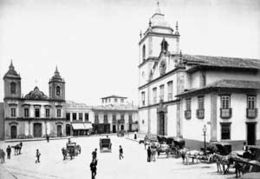
Praça da Sé
Encyclopedia
The Praça da Sé is a public space in São Paulo
, considered the center of town, because is the point from where the distancy of all roads that pass on São Paulo are counted. The square was the location of many historic events in São Paulo's history, most notably during the Diretas Já
movement. The name originates from the episcopal see
of the city, the São Paulo Cathedral
 Originally known as Largo da Sé (Field of the See), the square developed around the religious building which preceded the cathedral and surrounding edifices. At the beginning of the 20th century, older structures were demolished and the downtown area reconstructed according to the urban planning
Originally known as Largo da Sé (Field of the See), the square developed around the religious building which preceded the cathedral and surrounding edifices. At the beginning of the 20th century, older structures were demolished and the downtown area reconstructed according to the urban planning
of the time. Its geography has remained mostly unchanged since.
is the result of a 1970s project by architects led by José Eduardo de Assis Lefèvre. The opening of a nearby São Paulo Metro
station required the leveling of an entire city block, requiring an entirely new landscaping infrastructure.
The architects were heavily influenced by contemporary landscaping works underway in the west coast of the US (such as those by Lawrence Halprin
), characterized by rigorous geometry, through multiple levels with reflecting pool
s and prism-like land masses.
. The renovation came under intense criticism by NGOs working with the homeless who claimed that the new square reduced the space available for existing homeless people
The renovation includes the relocation of flower boxes, the increase in the integration between existing sculptures and their surroundings and the introduction of pedestrian overpasses over the existing reflecting pools.
São Paulo
São Paulo is the largest city in Brazil, the largest city in the southern hemisphere and South America, and the world's seventh largest city by population. The metropolis is anchor to the São Paulo metropolitan area, ranked as the second-most populous metropolitan area in the Americas and among...
, considered the center of town, because is the point from where the distancy of all roads that pass on São Paulo are counted. The square was the location of many historic events in São Paulo's history, most notably during the Diretas Já
Diretas Já
Diretas Já Now) was a civil unrest movement which, in 1984, demanded direct presidential elections in Brazil.-Participants of the movement: The movement brought together diverse elements of Brazilian society. Participants came from a broad spectrum of political parties, trade unions, civil,...
movement. The name originates from the episcopal see
Episcopal See
An episcopal see is, in the original sense, the official seat of a bishop. This seat, which is also referred to as the bishop's cathedra, is placed in the bishop's principal church, which is therefore called the bishop's cathedral...
of the city, the São Paulo Cathedral
History

Urban planning
Urban planning incorporates areas such as economics, design, ecology, sociology, geography, law, political science, and statistics to guide and ensure the orderly development of settlements and communities....
of the time. Its geography has remained mostly unchanged since.
Landscape project
The current landscapeLandscape
Landscape comprises the visible features of an area of land, including the physical elements of landforms such as mountains, hills, water bodies such as rivers, lakes, ponds and the sea, living elements of land cover including indigenous vegetation, human elements including different forms of...
is the result of a 1970s project by architects led by José Eduardo de Assis Lefèvre. The opening of a nearby São Paulo Metro
São Paulo Metro
The São Paulo Metro is the principal rapid-transit system in the city of São Paulo and the largest in Brazil. It is also the second largest system in South America and the third largest in Latin America, behind Mexico City and Santiago....
station required the leveling of an entire city block, requiring an entirely new landscaping infrastructure.
The architects were heavily influenced by contemporary landscaping works underway in the west coast of the US (such as those by Lawrence Halprin
Lawrence Halprin
Lawrence Halprin was an influential American landscape architect, designer and teacher.Beginning his career in the San Francisco Bay Area, California, in 1949, Halprin often collaborated with a local circle of modernist architects on relatively modest projects. These figures included William...
), characterized by rigorous geometry, through multiple levels with reflecting pool
Reflecting pool
A reflecting pool or reflection pool is a water feature found in gardens, parks, and at memorial sites. It usually consists of a shallow pool of water, undisturbed by fountain jets, for a calm reflective...
s and prism-like land masses.
Renovation
The square underwent a significant renovation during 2006, having been partially re-inaugurated on January 25 2007 (the city's birthday) by then-mayor Gilberto KassabGilberto Kassab
Gilberto Kassab is a Brazilian politician, current mayor of São Paulo. His term ends in 2012. A civil engineer and economist, of Lebanese descent, Kassab took over from José Serra, after Serra decided to run for governor of São Paulo...
. The renovation came under intense criticism by NGOs working with the homeless who claimed that the new square reduced the space available for existing homeless people
The renovation includes the relocation of flower boxes, the increase in the integration between existing sculptures and their surroundings and the introduction of pedestrian overpasses over the existing reflecting pools.
External links
Sampa.art.brHistorical Assets Administration of the City of São PauloSampaCentroBibliogrraphy
- MACEDO, Silvio Soares e ROBBA, Fábio; Praças brasileiras; São Paulo:Edusp; ISBN 85-314-0656-0

